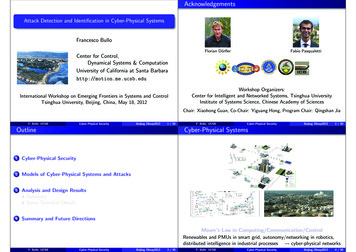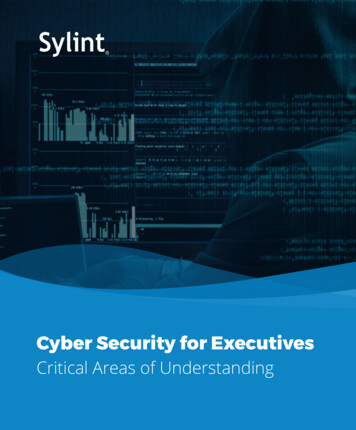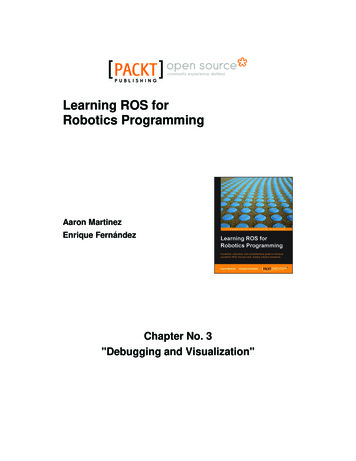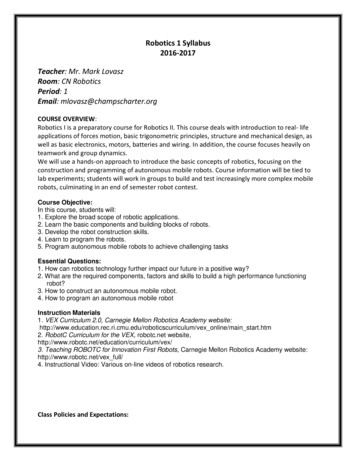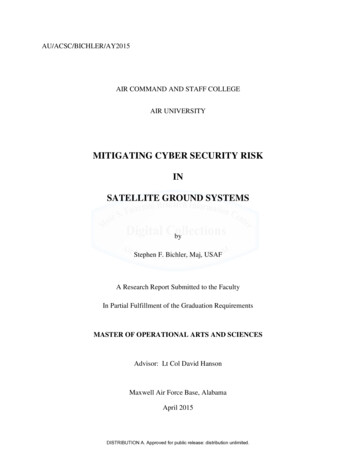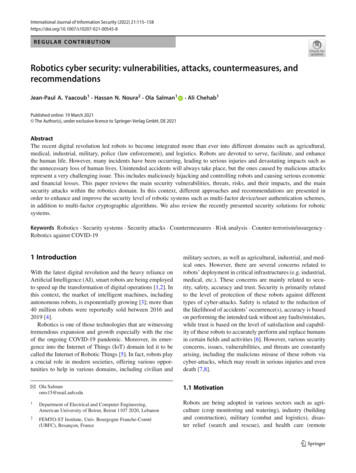
Transcription
International Journal of Information Security (2022) 45-8REGULAR CONTRIBUTIONRobotics cyber security: vulnerabilities, attacks, countermeasures, andrecommendationsJean-Paul A. Yaacoub1 · Hassan N. Noura2 · Ola Salman1· Ali Chehab1Published online: 19 March 2021 The Author(s), under exclusive licence to Springer-Verlag GmbH, DE 2021AbstractThe recent digital revolution led robots to become integrated more than ever into different domains such as agricultural,medical, industrial, military, police (law enforcement), and logistics. Robots are devoted to serve, facilitate, and enhancethe human life. However, many incidents have been occurring, leading to serious injuries and devastating impacts such asthe unnecessary loss of human lives. Unintended accidents will always take place, but the ones caused by malicious attacksrepresent a very challenging issue. This includes maliciously hijacking and controlling robots and causing serious economicand financial losses. This paper reviews the main security vulnerabilities, threats, risks, and their impacts, and the mainsecurity attacks within the robotics domain. In this context, different approaches and recommendations are presented inorder to enhance and improve the security level of robotic systems such as multi-factor device/user authentication schemes,in addition to multi-factor cryptographic algorithms. We also review the recently presented security solutions for roboticsystems.Keywords Robotics · Security systems · Security attacks · Countermeasures · Risk analysis · Counter-terrorism/insurgency ·Robotics against COVID-191 IntroductionWith the latest digital revolution and the heavy reliance onArtificial Intelligence (AI), smart robots are being employedto speed up the transformation of digital operations [1,2]. Inthis context, the market of intelligent machines, includingautonomous robots, is exponentially growing [3]; more than40 million robots were reportedly sold between 2016 and2019 [4].Robotics is one of those technologies that are witnessingtremendous expansion and growth especially with the riseof the ongoing COVID-19 pandemic. Moreover, its emergence into the Internet of Things (IoT) domain led it to becalled the Internet of Robotic Things [5]. In fact, robots playa crucial role in modern societies, offering various opportunities to help in various domains, including civilian andmilitary sectors, as well as agricultural, industrial, and medical ones. However, there are several concerns related torobots’ deployment in critical infrastructures (e.g. industrial,medical, etc.). These concerns are mainly related to security, safety, accuracy and trust. Security is primarily relatedto the level of protection of these robots against differenttypes of cyber-attacks. Safety is related to the reduction ofthe likelihood of accidents’ occurrence(s), accuracy is basedon performing the intended task without any faults/mistakes,while trust is based on the level of satisfaction and capability of these robots to accurately perform and replace humansin certain fields and activities [6]. However, various securityconcerns, issues, vulnerabilities, and threats are constantlyarising, including the malicious misuse of these robots viacyber-attacks, which may result in serious injuries and evendeath [7,8].BOla Salmanoms15@mail.aub.edu1.1 Motivation1Department of Electrical and Computer Engineering,American University of Beirut, Beirut 1107 2020, Lebanon2FEMTO-ST Institute, Univ. Bourgogne Franche-Comté(UBFC), Besançon, FranceRobots are being adopted in various sectors such as agriculture (crop monitoring and watering), industry (buildingand construction), military (combat and logistics), disaster relief (search and rescue), and health care (remote123
116surgeries, remote deliveries, anti-COVID-19 use, etc.). However, recent robotic-related incidents and misuses gainedthe media’s attention, where casualties or/and fatalitiescases were reported in incidents related to terrorism/cyberterrorism, sabotage, and espionage. Therefore, this paperdiscusses why robot manufacturers must consider safety,security, and accuracy in their initial design, and it highlightsthe recent efforts and robotic-based solutions to overcomeand reduce the impact and spread of COVID-19, with lessonslearnt to overcome any possible future pandemic spread.J.-P. A. Yaacoub et al.security aspect, with no clear security and safety recommendations being made with respect to designing secure and saferobotic systems. As such, the objective is to ensure that futuresecurity solutions strike a good balance between robots’ performance and their corresponding security and safety levels.Moreover, several recommendations were presented for thedesign of secure robotic systems in addition to identifying aset of possible research directions within the robotic securitydomain.1.3 Objectives and contributions1.2 Related workAccording to [9], various robotic challenges were discussed,out of which, security was considered among the hardest ones. Advanced robot systems became more prone toa variety of cyber-attacks [10–12] that target their data or(operating) systems’ confidentiality, integrity, availability,authentication, and/or privacy [13,14]. The main securitythreats and vulnerabilities targeting robotic systems weredescribed in [15,16]. Furthermore, a set of known roboticcyber-attacks were presented in [17] and various efforts werecombined to reduce the exposure of the Robot OperatingSystem (ROS) to various security vulnerabilities, as indicated in [18]. Moreover, a set of energy-efficient securitymechanisms were presented in [19]. In [20], Guiochet etal. investigated the safety of applications based on robotshumans interaction . In [21], Dieber et al. evaluated thesecurity of ROS by applying penetration tests while presenting countermeasures to harden its security. A recentwork [22,23] listed the current cyber-defence trends inindustrial control systems. In addition, in [24], Jahan etal. reviewed the secure modelling of autonomous systemsincluding robotic ones.Unfortunately, the related work lacks a global understanding of the robotics security issues and their causes. Moreover,no recommendations have been made in regards of designingsecure robotic systems.Therefore, this paper highlights the main robotic domainsof use, fields of operation, and application fields. In addition,this paper surveys the main security threats and vulnerabilities that surround the robotic domain while presenting avariety of suitable solutions to mitigate them. In fact, a riskassessment is also presented in a qualitative manner basedon the risk level and occurrence, and presenting their mostsuitable solutions. This paper also presents the main applications of robotics in the global fight against the ongoingCOVID-19 pandemic, especially with the use of ArtificialIntelligence (AI) and Machine Learning (ML) solutions [25],while highlighting additional robotic technologies [26–28],and the importance of their applications in tele-medicine andvirtual clinics/care domains [29]. In summary, this work aimsto summarize the existing solutions that only focus on a single123The objective of this paper is to highlight the importance ofadopting the various robotic techniques (i.e. drones, robots,underwater vehicles, AI, etc.) in every aspect of both thecyber and physical worlds. Also, the paper emphasizes thatthe robotic domain suffers from a set of security and safetythreats that can lead to dangerous attacks. In this context,we review the robotics security threats, vulnerabilities, andattacks, in addition to providing a qualitative risk assessment for these attacks. Equally important, we present a set ofpossible solutions to overcome these attacks. Moreover, therobustness and efficiency of these solutions are analysed, andwe suggest several recommendations to increase the securitylevel of robotic systems. In summary, this paper provides aglobal review about the robotic security, which is not wellpresented in the literature.The main contributions of this paper can be summarizedas follows:1. We illustrate the multi-purpose use of robots in variousdomains, to set the stage for the understanding and evaluation of robotic security attacks and their impacts.2. We highlight the different security vulnerabilities, risks,types of attacks, and their sources.3. We present a new taxonomy of how attacks take place,along with their impact, nature, structure, and concerns.4. We propose a list of recommendations and securityrequirements to safeguard robots against such attacks,to minimize their damage, and hence, to make the corresponding applications safer to deploy and use.1.4 OrganizationThis paper consists of eight sections and is organized as follows: Sect. 2 reviews the use of robots in multiple domains.Section 3 highlights the robotics issues and challenges,including the main security threats, risks, and vulnerabilities. Section 4 classifies the main robotic cyber-attacksaccording to different layers such as physical and networklayers, where the main security and safety concerns are discussed, with a qualitative risk assessment being proposed. InSect. 5.1, the robotic cyber-threat intelligence is presented
Robotics cyber security: vulnerabilities, attacks, countermeasures, and recommendations1172.2 Medical fieldalong its advantages, while also highlighting three activeresponses including active security awareness, response, andmanagement. In Sect. 5, different effective security countermeasures are discussed to ensure protection for roboticsystems’ layers. The authentication, identification and verification processes are also discussed, along with the needfor effective multi-factor authentication techniques to restrictaccess to authorized privileged robots/users only. In Sect. 6,we present the main security requirements and recommendations for future research directions over the security aspectin the robotics domains. Section 7 concludes the paper.Robots have been deployed in the medical domain to beused in tele-medicine, virtual care, and remote treatment concepts [29,39]. In fact, they were designed to serve as medicalrobots, surgical robots, and hospital robots [40]. They areused to perform small surgeries accurately, and new medicalrobots are capable of performing Cardio-Pulmonary Resuscitation (CPR) [41].2 Robot application domainsRobots are used in agriculture due to their efficient andincreased performance in reducing manpower and resourceconsumption [42]. They are used to perform some tasks efficiently, especially when dealing with a large farming areathat requires at least a dozen of workers and several days.This enhances irrigation, crop testing, crop agriculture, andso on.Robots have been deployed in different domains and employed in different fields, including civilian and military ones,which are summarized in Fig. 1. The figure illustrates thevarious robotic usages in different fields of operations formany tasks and purposes such as photography, product delivery, agriculture, wildlife monitoring, policing, search andrescue, emergency response, crisis/disaster response, casualty evacuation, reconnaissance and surveillance, counterterrorism/insurgency, counter-IEDs/unexploded ordnance,border patrol, infrastructure inspections, and science. Thereare different types of robots depending on their fieldof operation: Unmanned Aerial Vehicles (UAVs) such asdrones, Autonomous Unmanned Aircraft Vehicles (AUAVs),Unmanned Aerial Combat Vehicles (UACVs) and UnmannedAircraft Systems (UASs) [30,31], Unmanned Ground Vehicles (UGVs) such as robots and autonomous vehicles [32],and Unmanned Underwater Vehicles (UUVs) such as underwater drones, Autonomous Surface Vehicle (ASV), RemotelyOperated Underwater Vehicles (ROUVs) and AutonomousUnderwater Vehicles (AUVs) [33,34].This section discusses the main use of robots in industrial [35,36], medical [37], disaster and agriculture fields, inaddition to police and military ones [30].2.3 Agriculture field2.4 Disaster fieldDisaster robots can be used to reach and find helpless peoplewho were isolated by floods, or stuck and lost somewhere [43,44]. Disaster robots can perform jobs and reach places thathumans cannot [45]. Their famous use was when Search andRescue (SAR) robots were deployed to locate and find lostThai cave boys safely [46]. Moreover, robots were used inthe firefighting domain [47,48], which helps in sparing thelives of firefighters and to access areas that are deemed toodangerous, too small, and/or too risky for firefighters. In fact,both robots and UAVs were used after the devastating Beirutport explosion that occurred at around 6:07 pm on August4th, 2020, to help with assessing the damage and impactradius, as well as in the search for missing personnel [49–52]. The explosion was caused by the alleged detonation of2750 tonnes of Ammonium Nitrate due to lack of properstorage, equivalent to 1.1 kilotons of TriNitroToluene (TNT),and is considered as one of the most powerful non-nuclearexplosions in history.2.5 Police and law enforcement field2.1 Industrial fieldIndustrial robots are mainly used in order to reduce manpower. Robots have become artificially smart and able toperform jobs faster, safer, and with higher efficiency [38].Such jobs include manufacturing, construction, transportation, and quality control. In particular, robots are being usedin hazardous locations to perform dangerous tasks. They arealso capable of performing repetitive tasks with the same precision and accuracy, better than their human counterparts.Robots are being deployed in various police fields, especiallywhen it comes to shooting down, neutralizing, or eliminating suspects in places that are considered too dangerous andthat could lead to the loss of valuable officers’ lives. A wellknown use case of this application is when the police used arobot strapped with a C4 explosive and detonated it in order tokill the Dallas shooter [53]. In fact, the Israeli police is knownto have used drones (i.e. spiderman urban assault drone), withothers equipped with tear gas to counter the Gaza protestsand to reduce the threat imposed by possibly armed infil-123
118J.-P. A. Yaacoub et al.Fig. 1 Robot’s use in certain fieldstrators [54,55] and burning/armed explosive incendiary kitesand balloons [56]. Indian, South African, and Dutch policeare also known to have used “Skunk” drones which are armedand equipped with pepper spray. The American police andlaw enforcement are also using “weaponized drones” armedwith tasers, tear gas, and rubber bullets [57].2.6 Military fieldMilitary robots became the latest adopted weapons to be usedin most of military operations, especially with the extensiveuse of Unmanned Aerial Vehicles (UAVs) to perform target detection and to launch airstrikes [58]. Moreover, robotswere used to counter the Improvized Explosive Device (IED)threat, especially in Iraq and Afghanistan [59]. In fact, theywere being used by the British army in Northern Ireland since1970s [60], to combat the IEDs threat imposed by the IrishRepublican Army (IRA) and its different factions and descendants [61–63]. Such robot techniques (Unmanned GroundVehicles (UGVs) and Unmanned Aerial Vehicles (UAVs))evolved and were also used by US-led NATO forces (including the UK) in Iraq and Syria [64,65], in Yemen, Afghanistan,and Pakistan [66–69]. Also, France used them in Mali, Soma-123lia, and Nigeria [70,71] against the Islamic State (ISIS/ISIL)and Al-Qaeda operatives, and other terrorist factions (i.e.Boko Haram, Al-Shabab). Turkey also used mainly combat drones (i.e. Bayraktar TB2), and UGV robots (TMR 2(Kutlu), Zafer (Victory) and KAPLAN) in its campaign inLibya (along the United Arab Emirates who used Chinesemade UCAVs: Wing Loong II [72]) against Haftar forces, andin Syria against Syrian troops, Kurdish factions and Hezbollah members [73,74]. Turkey also assisted Azerbaijan (usingloitering munition such as Alpagu and Kargu, and UCAVssuch as Bayraktar TB2) with help from Israel (using loitering munition such as Orbiter, Heron and Harop variants,and LORA missiles) [75,76] during the Nagorno-Karabakhconflict [77] against Armenia. Russia also reportedly useddrones and UGVs in its conflict in Syria, Libya, andUkraine [64,78,79]. Iran developed its own UGVs and UAVs,with many UAV variants being used in Yemen, Lebanon, Iraq,Syria, and Gaza (Shahed, Ababil, Ayoub, Samad, Mohajer,Karrar, Mirsad, Qasef, etc.) via its operators [80], advisers [81–83] and proxies (i.e. Houthis, Hamas, Hezbolah,Palestinian Islamic Jihad (PIJ)) [84–86]. However, Israelextensively relied on developing Anti-UAV/UGV countermeasures (i.e. Iron Dome patriot missiles, AI-based sensors,
Robotics cyber security: vulnerabilities, attacks, countermeasures, and recommendations119facial-recognition and heat-measuring cameras, jammers,laser-guided weapons, etc.), and introduced its own advancedversion of UAV and UGV variants to combat the threateningIranian presence in Syria (Unit 840, trans-border operationsnear Golan Heights), Southern Lebanon (Hezbollah tunnelsand cross-border operations) [87–89], the West Bank andGaza Strip [Hamas Group 9 specializing in tunnel warfare,cross-border operations (Nahal Oz tunnel attack, 2014 [90]),and Naval Commando Unit specializing in underwater tunnelcapabilities, and underwater naval operations (Zikim BeachLanding, 2014)] [91–93]. Finally, armed drone swarms orUninhabited Air Vehicles (UiAVs) may well be used by theUK next summer in 2021.Robots were also used in the precision-guided munitions,precision-guided fragmentation munitions, precision-guidedairstrikes and shelling, smart bombs and Satellite Navigation(SATNAV) munition [94–96]. Moreover, robotics becameincluded in the naval warfare domain as part of autonomousboats, ships, submarines, torpedoes and as part of NavalMine Counter-Measures (NMCM), passive Anti-SubmarineWarfare (ASW) [97–99], anti-piracy operations (i.e. Somalian coasts, Nigeria’s Niger Delta, Gulf of Guinea, Gulf ofAden [100,101], and Guardafui Channel) and counteringterrorism, relying on the Combined Task Force 150 (CTF-150stationed in Bahrain) and the establishment of the MaritimeSecurity Patrol Area (MSPA)) [102–104].In fact, the robotic technology was not excluded frombeing adopted and used by both terrorists and insurgentsalike. Robotics including tele-operated sniper rifles, assaultrifles and machine guns, as well as remote-controlledautonomous vehicles and unmanned ground vehicles mounted with heavy machines guns were extensively used inconflicts such as in Syria, Iraq, and Libya by different fighting factions and insurgent groups (i.e. ISIS/ISIL, Al-Nusra,Al-Qaeda and Anti-Guaddafi forces) [105–107], in additionto the extensive use of drones and UAVs [108–110], and ISISdeveloped their own techniques [111–114].UK, Germany, Belgium, Italy, Spain, Portugal, and Greece.Other countries were also reported to adapt a similar technique including Turkey, Hong Kong, China (Wuhan), SouthKorea, Japan, India (using Mitra medical robot), Singapore,Australia, and New Zealand to monitor cases and maintainmedical supply tests, labs and deliveries, aerial spray anddisinfection, as well as consumers delivery [116,119]. Moreover, there was a remarkably extensive use and reliance onAI tools by Middle Eastern and North African countries suchas Tunisia (using P-Guards or Robocop), Morocco, Bahrain,Saudi Arabia, Egypt, Qatar, Oman, Kuwait, the United ArabEmirates (i.e. Dubai), Lebanon and Israel including speedcameras, drones and robots to enforce quarantine rules,perform deliveries, and maintain social distancing [120–122], aside using police/military patrols and helicopterswith speakers. In fact, drones were also used to monitorcases and ensure medical deliveries and testing samplesto limit the COVID-19 outbreak in Africa [123]. Medicalsurgeries and operations were also carried out by robotsincluding humanoids to reduce the exposure of medicalstaff that was already stressed out due to high COVID19 cases [124,125]. Thus, this paves the way to futuristicrobotics-assisted telemedicine and telehealth applications,based on the lessons learnt and to-be-learnt, during the Ebolaoutbreak and the ongoing COVID-19 pandemic, such as thesmart field hospital trial in Wuhan, China, and the use ofsmart medical “Xiao Bao” robot [126], as well as the useof “companion robots” to combat loneliness [127]. This willhelp in remotely examining and monitoring infected patients,controlling the outbreak, minimizing the exposure, disinfecting areas, delivering medicines and food, raising awareness,and measuring vital signs for early detection.2.7 Counter-pandemic fieldDespite the great advantages and promising future the roboticfield holds, some major concerns are still lurking around, andimposing serious threats and issues [128] that can potentiallyaffect both humans and machines. For this reason, these mainissues and challenges are presented in this section.During the ongoing COVID-19 pandemic caused by theSARS-CoV-2 virus [25], which started its outbreak in late2019, the extensive use of robots, drones, UAVs, autonomousand unmanned vehicles grew fast, along the adoption of AIand ML techniques to ensure a faster detection of infectedpersonnel and to limit the outbreak and infection rates [115].In May 2020, a drone representing the “Anti-COVID-19Volunteer Drone Task Force” was urging New-Yorkers towear their masks and maintain their social distancing, andrespect quarantine rules [116,117]. In France, “Big Brother”drones were used to enforce social distancing before beingbanned in May 2020 [118]. Other European countries alsoincluded the use of drones and robots such as Finland, Russia,3 Robotics security: issues, vulnerabilities,threats, and risks3.1 Security issuesRobotic issues are not limited to one, but to many aspects thatcould exploit any vulnerability/security gap to target roboticsystems and applications alike [10,10,129]. The aim is toidentify and classify them to gain a better insight, which helpsother fellow researchers in their quest to identify, tackle andovercome them.123
120 Lack of secure networking which renders the communication between robots/machines and humans insecureand prone to various attacks [130,131]. Lack of proper authentication which leads to an unauthorized access using standard usernames and passwords,which can be easily trespassed by a given attacker. Lack of confidentiality which is due to the use of weakencryption algorithms that can be easily broken, leadingto the interception and exposure of robotic sensitive dataand design plans. Lack of privacy can result in the exposure of business deals and trades that can affect the reputation of agiven organization, and the exposure of the collaborationbetween different robotic security firms. Lack of integrity which is due to the use of weak messageauthentication protocols that can be easily compromised,leading to the alteration of robotic sensitive data, storedor in transit. Lack of verification which does not include strong biometric features to prevent any abuse of privilege orunauthorized access. Lack of authorization it defines the right physical accessbased on the assigned access controls inside robotic labs,factories, and industries [10]. Misconfiguration and bad programming which may render the robotic systems and operating systems incapableof performing the intended tasks at the required accuracylevel, and thus, threatening their human operators andbadly affecting the software features. Lack of tamper-resistant hardware renders robots proneto damage and/or partial/total destruction, which can leadto the loss of the robot’s functional and operational capabilities. Lack of self-healing processing leaves the robotic system prone to the possibly of cascading attacks with theinability to recover or react in time to prevent furtherdegradation in its performance. Hence, a self-healingprocess is required to ensure that robotic systems cansense faults or disruptions and can reconfigure the backup resources. Lack of safety designs is very risky and has proven inmany real-case incidents to be lethal and threateningtowards humans with a remarkable number of casualtiesand fatalities, aside the economic/financial losses. Lack of security by-design features leads to breakinginto the robotic system’s architecture and design to scanand exploit its vulnerability/security gap(s) for furtherattacks, including malicious data injection and modification [10]. Lack of AI-based designs affects the operational and functional performance of robots when being assigned a task,with both accuracy and performance being affected.123J.-P. A. Yaacoub et al. Lack of update for the robotic operating system, firmware,and software may result in various cyber-physical attacks. Lack of advanced IDS solutions is also a major issue,especially when relying on intrusion detection systemthat either detect anomaly, behaviour or signature pattern of a given malware, rather than relying on advancedhybrid and lightweight or AI-based IDS solutions. Thesame is true for the use of Honeypots. Lack of penetration testing could lead to security breachesof the deployed applications. Lack of security patches increases the chance of basicand advanced attacks such as stealing of sensitive data,remote access, and rootkit. Lack of personnel training is also a serious issue sincepersonnel working in the coding robotic domain, or ashuman operators, or as IT or chief executives, are targetedby social engineering, reverse engineering and phishingattacks. Lack of human–machine collaboration could affect thehuman activity in terms of labour, work, and performance. Lack of employee screening could result in having aninsider attack led by a whistle-blower that leaks sensitive data and exposes classified information and sensitiverobotic details.3.2 Security vulnerabilitiesRobotic systems are prone to various vulnerabilities [132,133] that can affect their performance in terms of connectivity, productivity, operations, and accuracy. This paperpresents several vulnerabilities that are challenging: Network vulnerability with the lack or the adoption ofbasic security measures, robotic systems are vulnerable tovarious wired/wireless communication and connectionsattacks including replay, man-in-the-middle, eavesdropping, sniffing, spoofing, etc. Platform vulnerability includes the lack of constantupdates of software and firmware patches, as well assecurity patches to maintain a secure up-to-date roboticsystem. This results into also having configuration anddatabase vulnerabilities. Application vulnerability applications that are not testedand evaluated for coding or compatibility bugs, can alsoaffect the robotic system’s performance. Hence, furthertesting is essentially required. Security vulnerability the adoption of new security measures without thorough testing can sometimes affect theperformance of both robotic systems and devices. Hence,testing is essential before deployment. Bad practice vulnerability includes the bad choice ofsecurity measures and means, as well as lack of coding
Robotics cyber security: vulnerabilities, attacks, countermeasures, and recommendationsskills, which can be easily re-modified to cause errors orto perform the wrong tasks. Update vulnerability robots are also prone to update vulnerabilities that can cause their systems and operatingsystems to act differently due to the new update, including the loss of unsaved data, interruption of the ongoingprocess, etc. Heterogeneity and homogeneity vulnerability the heterogeneous nature of robotic systems makes their integrationprone to many security issues. Moreover, their homogeneous nature also leaves them prone to similar attackswith possibly cascading effects. Management vulnerability includes the lack of advisedplanning, security guidelines, procedures and policies. 3.3 Security threats Robotics threats are growing, not only due to the concept ofindustrial competition, but also due spying and terrorism.3.3.1 Threat sourceThreats can originate from different sources [134], and canbe part of cyber-crimes, cyber-warfare, cyber-espionage, oreven cyber-terrorism. This paper lists the main ones as follows: Insiders (or whistle-blowers) are usually rogue or unsatisfied employees who aim to either steal robotic confidential information, or infiltrators that help outsiders toconduct their attack remotely through abuse of privilege.Insiders can also cause physical damage and destructionto robotic systems. Outsiders aim to gain access to a robotic system throughthe Internet. The external adversary’s aim is to get accessto information for malicious purposes [134], to causemalfunction or/and disrupt the system’s services throughthe injection of either fake or malicious data. Competitors usually, rivals in the robotic industry aim tomaintain a leading edge in this domain. Many methodscan be adopted such as the reliance on insiders, or part ofindustrial espionage to leak confidential documents anddamage the rival company’s reputation [135]. Incompetent developers include bad manufacturers andprogrammers who do not take into consideration theessential safety and security requirements upon the development of software for robots and machines. Incompetent operators include either ignorant users whodo not know how to use well a robot or a machine, ormalicious users who try to use the robot/machine for amalicious task. Cyber criminals including hackers whose aim is puttheir cyber-attack capabilities into action via scanning 121for security gaps or software/firmware vulnerability andexploiting them.Organized criminals unlike cyber criminals, they breakinto a given company and steal robotic components, parts,designs, or architecture plan in order to sell it into theblack market to rival companies, or for their own personalgains.Mal
This paper reviews the main security vulnerabilities, threats, risks, and their impacts, and the main . American University of Beirut, Beirut 1107 2020, Lebanon 2 FEMTO-ST Institute, Univ. Bourgogne Franche-Comté (UBFC), Besançon, France military sectors, as well as agricultural, industrial, and med-ical ones. However, there are several .


